#Nine Forms of Maa Durga
Explore tagged Tumblr posts
Text
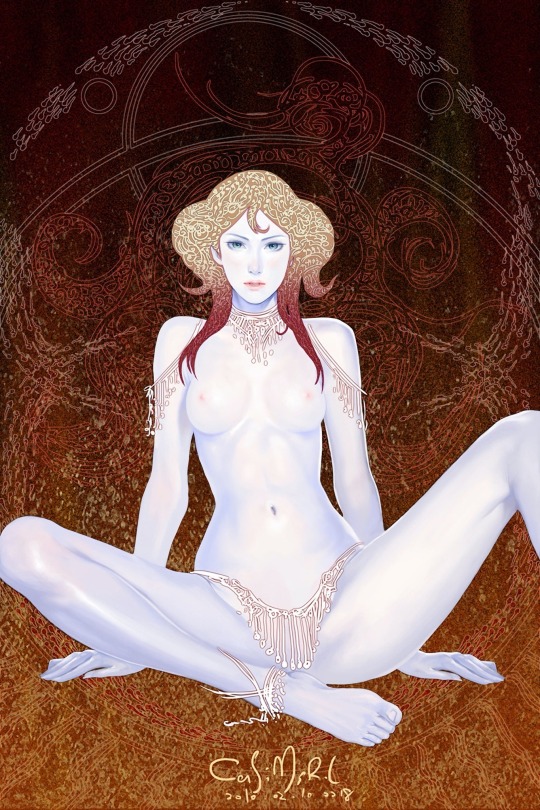
Nobody has created Adi Sakti Maa but she has only gave birth to all the living beings!
Adi Parashakti, Adi Shakti and Shakti are synonymes and represent the same power which has metamorphosed from one to another. If you look at it with eternity, they appear to be same, born out of the same things, yet appear distict from each other. Adi Parashakti represent the ‘Cosmic Power’ of Universe, Adi Shakti represent the ‘Ancient Power’ of Planet Earth and Shakti represent the ‘Power’ or ‘True Nature’ which is available on Earth.
Maa Durga which is the manifestation of Adi Shakti controls the nine planets to maintain the cosmic orders of universe. Maa Durga in her form of Nav Durga provides energy to the nine planets. Various forms of Nav Duga can be described as follows:-
Kushmanda Shakti governing the SUN
Mahagauri governing the RAHU
Kaal Ratri governing the SHANI
Shiddhi Dhatri governing the KETU
Katyayini governing the BRIHASPATI
Brahmcharini governing the MANGAL
Shail Putri governing the MOON
Skanda Mata governing the BUDDH
Chandraghanta governing the SHUKRA
During the days of Navaratra the power or cosmic energy of the divine mother Adi Parashakti is said to be the maximum on the earth. It is during this period that human beings can worship her to be bestowed with her powers to ward off the evil effects.
Adi Parashkti in her original manifestation devolved to Goddess Durga, Sati and Paravati.
Adi Parashakti artist: Casimir Lee
14 notes
·
View notes
Text

-Shailputri
Among the nine Durga forms, Shailputri is the first and foremost one. Since she is the Goddess of root chakra, devotees pray this form keeping the Mooladhar in mind. Goddess Shailputri is the daughter of Himalayas. She is a form of Mata Shakti (Goddess of Power) and spouse of Lord Shiva. Maa Shailputri has a half-moon on her forehead. She rides on Nandi. The abode of Maa Shailputri is believed to be in the Muladhara Chakra. Realising this divine energy is considered as an important step towards spiritual enlightenment. Watch this space for next nine days (starting from today) to know more about the remaining forms of Durga Maa..Adishakti.. With no beginning and no end..Symbol of divine power and purity!
credit
@zeherili-ankhein @no-idea-where-i-am-lost DID IT!!!
HOW'S IS IT?????
12 notes
·
View notes
Text
Day nine of Navratri
9 days, 9 Godesses

Day nine : Siddhidatri | सिद्धिदात्री
Purest form of energy
Siddhadhatri is pure energy-the first and purest form of energy. Modern science has only recently understood the concept of pure energy! She was formless but Shiva supplicated her and she became Adi Shakti. In her Parvati attained her supreme form as a complete manifestation of Mahashakti or the primeval power.
Siddhi means supernatural power and dhatri means the giver. So she is the sole source of all power-both material and spiritual. She is capable of giving us all the eight siddhis-ashta siddhis or supernormal powers.
Mantra for the day:
ॐ देवी सिद्धिदात्र्यै नमः ॥ "Aum Devi Siddhidhatrayai Namaha!"
Jai Maa Durga 🔱
40 notes
·
View notes
Text
Chaitra Navratri 2024 Kab Hain | Know The Date, Time & Importance | Bhakti Aanand
Nine forms of Goddess Durga are worshiped during Navratri. Prasad and bhog also vary depending on the incarnation of the goddess. Different forms of Adishakti Maa Durga are worshiped for 9 days. Chaitra Navratri has a prominent place among the fasts and festivals of the month of April in the year 2024. Let us know what will be the date and time of Chaitra Navratri this year and on which day which goddess will be worshipped.
2 notes
·
View notes
Text
Nine Mukhi Rudraksha – Full Benefits and Details
nine Mukhi Rudraksha nine Mukhi Rudraksha has 9 natural vertical lines on its surface. This OrignalRudraksha is found mostly in Nepal and Java. This is also the favorite Rudramanaka of Mother Shakti and Navmukhi Rudraksha ithe representative of Goddess Durga endowed with Navshakti. The blessings of Kapil Muni and Bhairodev keep showering on this Rudraksha. It is especially worn as a protective shield, protecting the wearer from all types of evil properties, black magic and negativity. It provides strength and energy to the wearer. The ruling planet of 9 Mukhi Rudraksha is Ketu.
Unlike other Rudraksha, which display some or the other form of Lord Vishnu, but this bead represents the power of Maa Durga. This Rudraksha works as a home remedy to remove any kind of negative effects of malefic planets. According to Vedic astrology, planets influence the lives of humans. Since planets are always in motion, in the context of astrology, this transit occurs from one zodiac sign to another from time to time. The speed of some planets is slow while the speed of some planets is fast. All these planets keep changing their behavior negatively and positively with every transit. Based out of a zodiac sign, an astrologer makes predictions about the movements of those planets and informs you about good and bad times. It will also tell you about those planets which are negatively affecting your life. 9 Mukhi Rudraksha helps in reducing the negative effects of malefic planets.
Benefits of wearing 9 Mukhi Rudraksha Helps in employment, personality development and success in interviews.
It makes the wearer confident and powerful.
It removes the fear of time from the mind of the wearer and gives him the freedom to live freely.
It helps in removing the malefic effects of planets Ketu and Rahu.
It blesses women to attain physical and mental strength
It is recommended for career oriented women
It removes stomach related problems
It also helps in curing body aches, allergies affecting the skin
It boosts confidence in the wearer.
It helps in keeping a check on Kaal Sarp Dosh
It helps to establish connection with the universe by healing the Sahasrara Chakra
It keeps negative energy away from the wearer
It helps in warding off all kinds of enemies
It helps in destroying all the sins and worries of the person and connects him with Goddess Durga.
It associates the wearer with bravery, courage and endurance.
It helps in making the wearer positive and dynamic.
It helps improve the functioning of the brain and nervous system.
It helps in treating the problems of dizziness and vertigo.
It helps in removing phobias, anxieties and hallucinations in the person.
It helps in maintaining balance between worldly affairs and spiritual life.
It helps in treating epilepsy in the person.
It helps in removing depression and physical weakness of the Rudraksha wearer.
Method of wearing 9 Mukhi Rudraksha Saturday is considered to be the auspicious day to wear 9 Mukhi Rudraksha. First of all, keep Rudraksha in a copper vessel and sprinkle Ganga water on it. Then sit in the east direction of your temple and chant the mantra “Om Hreem Hoon Namah” and wear Rudraksh and chant it 108 times. If your astrologer suggests you to chant some additional mantras then you can do accordingly.
Note: Make sure that the Rudraksha is in direct contact with your body, so that its effect is fully visible to you.

#rudraksha#mahadev#bholenath#kedarnath#mahakal#shivay#omnamahshivaya#rudrakshabeads#shiv#harharmahadev#kedarnathdham#rudra#lordshiva#india#tungnath#rudraksh#pahadi#uttarakhand#rudraprayag#uttarakhandi#omkareshwar#shivatemple#rudrakshamala#kedarkantha#rudranath#mahakaleshwar#What is the mantra for 9 Mukhi Rudraksha?#Who can wear 9 Mukhi Rudraksha?#What is the price of 9 Ratti Rudraksha?#What is the price of 9 face Nepal Rudraksha?
2 notes
·
View notes
Text
MAA DURGA
Maa Durga, also known as Goddess Durga, is a powerful and widely revered deity in Hinduism. She is considered the embodiment of feminine energy and is worshiped as the divine mother and the supreme goddess.
👑 Maa Durga is often depicted as a beautiful and fierce goddess with multiple arms, each holding a weapon. She rides a lion or tiger, symbolizing power and bravery. Her image represents the triumph of good over evil.
🗡️ According to Hindu mythology, Maa Durga was created by the combined energies of various deities to defeat the buffalo demon Mahishasura, who was causing chaos and terror in the world. It is believed that she fought a fierce battle with Mahishasura for nine nights and ultimately defeated him on the tenth day, known as Vijayadashami or Dussehra.
🎉 The festival of Navaratri, meaning "nine nights," is dedicated to the worship of Maa Durga. It is celebrated with great enthusiasm and devotion in many parts of India and by Hindu communities around the world. During Navaratri, various forms of the goddess are worshiped, and traditional dances and music performances called "Garba" and "Dandiya" are organized.
🪔 The most popular time to worship Maa Durga is during the festival of Durga Puja, which is widely celebrated in the Indian states of West Bengal, Odisha, Assam, and other parts of India. Elaborately crafted idols of the goddess are worshipped in temporary structures called pandals, and grand processions, cultural performances, and feasts are organized during this time.
🌺 Maa Durga is believed to possess various divine qualities and attributes. She is considered the embodiment of power (Shakti), motherly love, compassion, and righteousness. Devotees seek her blessings for protection, prosperity, and spiritual fulfillment.
🙏 The prayers and hymns dedicated to Maa Durga, such as the Durga Chalisa and the Devi Stuti, are chanted by devotees to invoke her blessings and seek her divine intervention in their lives.
🌼 Maa Durga is not only worshipped by Hindus but is also respected and revered by people of different faiths as a symbol of strength, courage, and feminine power.
🔱 Overall, the worship of Maa Durga holds immense significance in Hinduism, and she is revered as the divine mother who protects her devotees and removes obstacles from their lives.
2 notes
·
View notes
Text
Worship Maa Kaalratri - Durga Devi on the 7th day of Navaratri
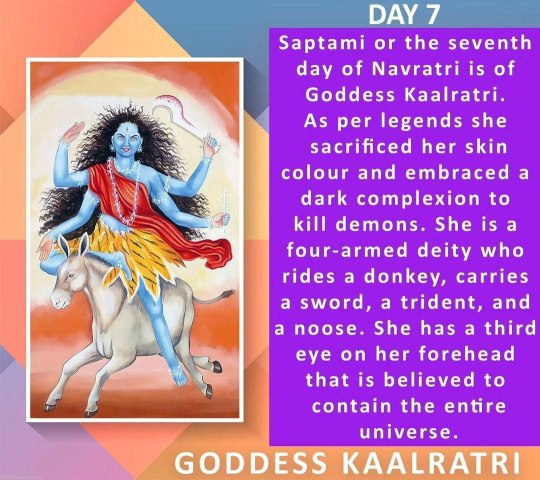
🌹 Worship Maa Kaalratri - Durga Devi on the 7th day of Navaratri 🌹
The 7th day of Navaratri is dedicated to Maa Kalratri, the 7th Avtar of Maa Durga. Here, Kaal means time and death and Kaalratri means the One who is the Death of Kaal. Maa Kalratri destroys ignorance and brings light into the dark. Well, this form also depicts the dark side - the super power that creates havoc and removes all things bad and dirty. But to Her devotees, She brings calmness and courage.
Maa Kaalratri has dark complexion. Donkey is Her mount, She has bountiful hair and four hands. One of the two left hands holds a cleaver and the other holds a torch, and the right two hands are in "giving" and "protecting" mudras. She has three eyes emanate rays like lightning and Her necklace is shining like thunder. When She inhales and exhales air, flames appear through Her nostrils. Ganesha advises you to wear Blue, Read and White colour on this day.
Kaalratri is the most fierce one among the nine durgas , simply because she gives the highest realization to her devotee by annihilating his / her mortal limitations and grants them fearlessness. Her fierceness represents her higher intensity , as even her ornaments are nothing else but high voltage electric waves . Highly intense means she gives transcendence to her bhakta easily by making them quickly suffer their accumulation of past mortal karmas.
She is meditated upon in a form with untied long hair , she is digambara or naked as she is the entire cosmos and their can hardly be any clothes made for her as external covering because she is everything . She holds a shinny sword and a Vajra ( thunderbolt ) in left upper and lower hand and abhaya and Vara mudras in right upper and lower hands . She's seated on a gardabh / donkey , which shows that every creature is beloved of Divine Mother . Her face expression is Raudramukhi / fierce with wide big open eyes and a gentle smile on her lips.
🍀. Spiritual Significance 🍀
In Durga Saptashati , Kaalratri is mentioned along with the three spiritual nights . Kaalratri means the night of dissolution. As earlier told her ornaments and body are charged electric waves which reveals that anything which goes close to her will merge / dissolve in her . She'll release them from mortality , hence she grants Moksha or liberation to her devotees . She is also called Shubhankari for the same reason in shastras , as Moksha the highest transcendental liberation which is difficult to experience is granted easily by her . Easy means the fruits of selfless Sadhna will yield auspicious results with her grace.
Maa teaches us that sorrow, pain, decay, destruction and death are unavoidable and cannot be ignored. These are the truths of life and denying them is futile. We must accept their presence and significance to realise the fullness of our being and our potential.
Kaalratri is also called Bhayankari , the dangerous one whose name itself terrorises the demons and all other negative forces. She destroys fear in her devotee's mind and grants them wisdom to cross the ocean of samsara / physical life effortlessly.
🌷Mantra and other Facts Recite the below-mentioned Mantras to get the blessing from the almighty Maa Kalratri.
ॐ देवी कालरात्र्यै नमः
Om Devi Kalaratryai Namah
या देवी सर्वभूतेषु माँ कालरात्रि रूपेण संस्थिता।
नमस्तस्यै नमस्तस्यै नमस्तस्यै नमो नमः
Ya Devi Sarvabhuteshu Ma Kalaratri Rupena Samsthita Namastasyai Namastasyai Namastasyai Namo Namah
Performing necessary rituals and chanting of mantras are important for a successful Puja. A Puja performed with correct Vedic rituals and mantras can help you bring positivity to your life and do away with the negativity. Gain the maximum out of your personalised Puja performed by our adept Panditji.
Although the Goddess Kalaratri is the most ferocious form of Goddess Durga, she blesses her devotees with Abhaya and Varada Mudras. Because of her Shubh or auspicious power within her ferocious form Goddess Kalaratri is also known as Goddess Shubhankari.
🌹 🌹 🌹 🌹 🌹
#జ్ఞానవాహిని#Spiritual#Bhakthi#Insight#సందేశాలు#Jnanavahini#message of the day#Devi Navaratri#prasad bharadwaj
2 notes
·
View notes
Text
#नवरात्रि_पर_पाएं_ज्ञानगंगा
The nine forms of Durga are called sin destroyers, but can Durga Maa really destroy our sins? Know who is the true father of the soul who destroys sins. To know, you must read the book "Gyan Ganga".
#Navratri

2 notes
·
View notes
Text
Difference between Chaitra Navratri and Sharad Navratri
Reading time- 5 mins
India, a land of diverse cultures and traditions, celebrates Navratri not once, but twice a year with great enthusiasm and devotion. Navratri, meaning 'nine nights,' is a Hindu festival dedicated to Goddess Durga and her various forms. These two celebrations, Chaitra Navratri and Sharad Navratri, hold unique significance and are observed at different times of the year. In this blog, we'll explore why Navratri is celebrated twice in India and delve into the captivating mythological stories behind the divine forms of Maa Durga.
Chaitra Navratri: Welcoming Spring
Chaitra Navratri falls in the Chaitra month of the Hindu calendar, typically in March or April. This festival marks the beginning of spring when nature awakens, and new life blossoms. During these nine days, devotees pay homage to Goddess Durga and seek her blessings for prosperity and good fortune.
Chaitra Navratri is believed to commemorate the day when Lord Rama, accompanied by his brother Lakshmana and devotee Hanuman, worshiped Goddess Durga to seek her blessings before embarking on his epic journey to rescue his wife, Sita, from the demon king Ravana. It symbolizes the victory of good over evil and the triumph of righteousness. The culmination of Chaitra Navratri is celebrated as Ram Navami.
Sharad Navratri: Celebration of the Harvest
Sharad Navratri, also known as Maha Navratri, is the more widely celebrated of the two. It falls in the lunar month of Ashwin, usually in September or October when the monsoon season ends and the country gears up for the harvest season. This grand festival celebrates the divine feminine and the goddess's prowess in defeating the buffalo demon, Mahishasura.
According to Hindu mythology, Mahishasura was a formidable demon who terrorized the gods. He received a boon from Lord Agni, according to which a woman would only kill him. Unable to defeat him, the gods created Goddess Durga, a symbol of ultimate feminine power. Durga fought Mahishasura for nine days and nights, ultimately slaying him on the tenth day, known as Vijayadashami or Dussehra. Sharad Navratri symbolizes the victory of good over evil, knowledge over ignorance, and light over darkness. It is the ultimate celebration of divine female energies.
Young girls all over India are worshipped as devotees who believe that the Devi resides in little girls.
Maa Durga is depicted in 9 various forms, each with its own significance and attributes, to defeat the shape-shifting demon: Mahishasura. During Navratri, these forms are celebrated on specific days, known as 'Navadurga.' Let's explore some of the most renowned forms:
Shailaputri: The first form of Durga, she is the daughter of the Himalayas and represents the purity and innocence of nature.
Brahmacharini: She symbolizes the pursuit of knowledge and is often depicted holding a rosary and a water pot.
Chandraghanta: This form represents bravery and courage, as she adorns a crescent moon-shaped ornament on her forehead.
Kushmanda: The creator of the universe, Kushmanda signifies the source of all energy and vitality.
Skandamata: As the mother of Lord Kartikeya, she stands for the power of a mother's love and protection.
Katyayani: This fierce form of Durga is worshiped for her ability to destroy evil forces and protect her devotees.
Kalratri: Depicting the dark side of life, she is a symbol of destruction and liberation from ignorance.
Mahagauri: This form represents purity and is often depicted in white attire, symbolizing peace and serenity.
Siddhidatri: The final form of Durga, Siddhidatri is believed to grant devotees spiritual powers and enlightenment.
Navratri is a spiritually enriching festival that honors the divine feminine. Whether it's the arrival of spring during Chaitra Navratri or the harvest season of Sharad Navratri, both celebrations remind us of the importance of faith, perseverance, and the victory of good over evil. The diverse forms of Maa Durga teach us valuable life lessons and inspire us to live virtuously.
Gujratis celebrate Navratri through vibrant Garba and Dandiya Raas dances, while in Bengal, this festival is celebrated as Durga Puja, which involves worshiping the goddess Durga with grand processions and cultural events. So, they celebrate Navratri, but how it's celebrated varies.
This Navaratri, bring home the divine presence of Goddess Durga with the Navaratri-Durga Puja Kit from Prabhu Shriram- Incense with a Story.
This pack contains-
Mata Vaishno Devi Agarbatti
Upasana Dhoop
Sambrani Cups
Havan Samagri
Divya Jyot
Mauli Dhaga
Guggal Loban
Jau
Pavitra Ganga Sand Soil
Red Cloth
Mata Chunri
Laung
Supari
Sindoor/Roli
Haldi
Akshat
Mishri/Kaju/Kishmish/Elaichi
Camphor
2 notes
·
View notes
Text
Navratri 2023 Colors: A Guide to the Significance of 9 Days of Sharad Navratri Attire
Navratri, the nine-night festival dedicated to the worship of Goddess Durga, is celebrated with great enthusiasm and devotion in India, especially in states like Maharashtra and Gujarat. One of the captivating traditions during Navratri is the daily choice of colors to wear, each associated with a different form of the goddess. This practice holds deep significance in Hindu culture, symbolizing purity. Let's take a closer look at the Navratri colors to be followed this year and the gods and goddesses they represent.
Day 1: Pratipada - Shailputri
On the first day of Navratri, Goddess Shailputri is venerated, also known as Parvati, the daughter of the Himalaya mountains. The color for this day is Orange, symbolizing energy and enthusiasm.

Image Courtesy: Pinterest
Adorn yourself in an elegant Orange and red Ikkat Pure Pochampally Handloom Saree to honor the goddess's strength and grace.
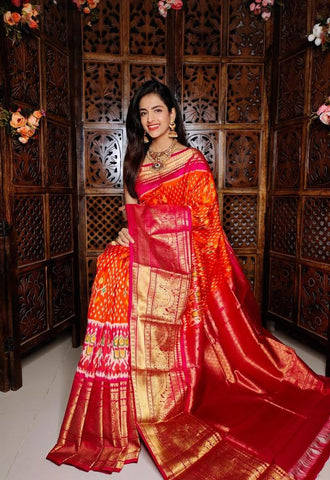
Day 2: Dwitiya - Brahmacharini
Mata Brahmacharini, the goddess celebrated on the second day, signifies eternal peace. White, the color of serenity, is the choice for Day 2.

Image Courtesy: Online live daily news
A Pearl White Color Mirror Work Viscose Rayon Navaratri Lehenga Choli reflects the goddess's tranquil and pure nature.
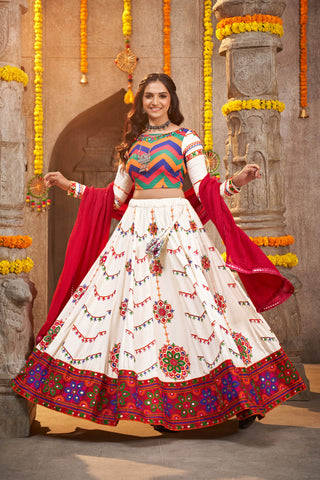
Day 3: Tritiya - Chandraghanta
On Tritiya, we worship Mata Chandraghanta, who rides a lion and is believed to vanquish evil forces. Red, the color of health, courage, and love, is the color of choice.
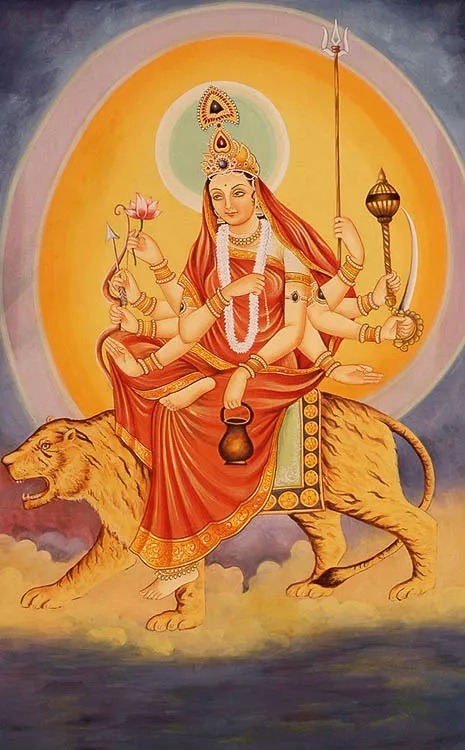
Image Courtesy: Pinterest
Embrace this vibrant hue with a Red saree cutdana work to channel your inner strength.
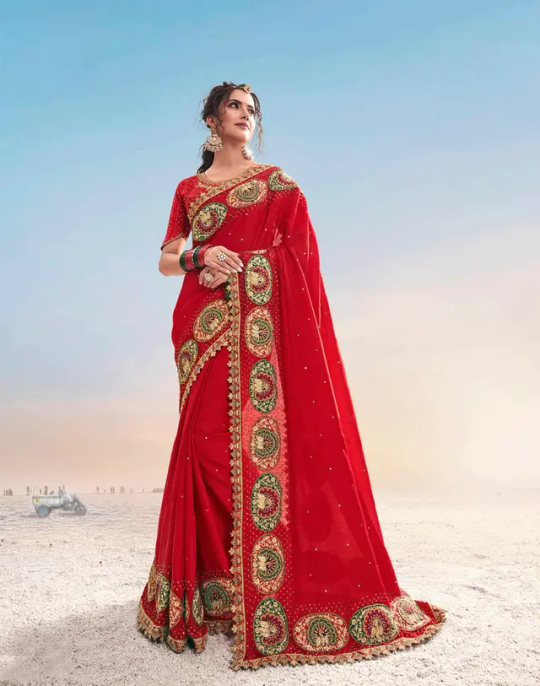
Day 4: Chaturthi - Kushmanda
The fourth day celebrates Mata Kushmanda, who is said to have created the cosmic egg with her smile, bringing light to the universe. Royal Blue, representing elegance and royalty, is the color for this day.

Image Courtesy: Pinterest
Grace the occasion with a splendid Navratri Chaniya Choli in this mesmerizing shade of Blue.
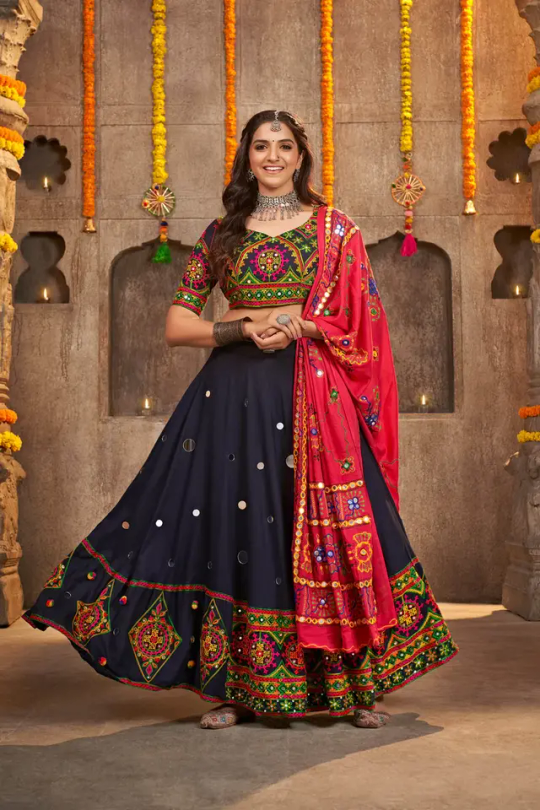
Image Courtesy: Pinterest
Day 5: Panchami - SkandMata
Mata Skandmata, honored on the fifth day, is associated with good health. This day is dedicated to Green, symbolizing nature and prosperity.

Image Courtesy: Pinterest
Wear this beautiful green saree to align with the goddess's blessings.

Day 6: Shashthi - Katyayani
Mata Katyayani, the sixth form of Mata Durga, is the granter of health and happiness. Grey, a vibrant and versatile color, is chosen for this day's celebrations.

Image Courtesy: Pinterest
Grace the occasion with a Grey Anarkali Dress

Day 7: Saptami - Kaalratri
Maa Kaalratri, worshipped on the seventh day, protects against evil forces. Orange is the color for Saptami, reflecting the fervor of Navratri celebrations.

Day 8: Ashtami - Mahagauri
Maa Mahagauri, associated with peace and intelligence, is revered on the eighth day.

Image Courtesy: Pinterest
Adorn yourself in Peacock Green indian saree, a sublime shade that complements the goddess's virtues.

Day 9: Navami - Siddhidatri
On the ninth and final day, we honor Maa Siddhidatri, the granter of divine blessings. Pink, a combination of the energy of red and the stability of blue, is chosen. This color symbolizes opulence and richness as we seek the goddess's supreme blessings.

Image Courtesy: Pinterest
During Navratri, people wear different colors each day to show that they are all together and devoted. It's like a colorful journey through different forms of the Goddess Durga, who is very special. When you celebrate Navratri, make sure to wear colors that show how much you love and respect the divine.
Explore the exquisite collection of Navratri attire at Mohi Fashion, featuring enchanting Chaniya Choli, Navratri Ghagra Choli, Anarkali suit, sarees, and stylish sharara suit, all available online. We proudly offer worldwide shipping, catering to fashion enthusiasts in the USA, Australia, UK, Canada, India, and beyond. Join us in celebrating the spirit of Navratri with elegance and style.
#navratri#lehenga#indian ethnic wear#sareelove#sareeonline#bride#wedding#indianfashion#sareecollection#bollywood#bollywood actress#ootd
2 notes
·
View notes
Text
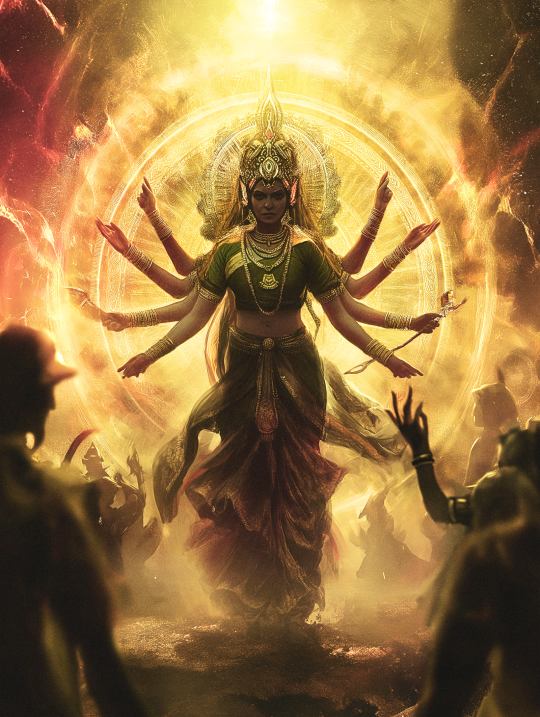
Maa Durga
Durga, in Hinduism, a principal form of the Goddess, also known as Devi and Shakti.
Happy Chaitra Navratri 2024!
Happy Chaitra Navratri 2024: The nine-day festival of Chaitra Navratri falls on April 9 this year. It will end with Ram Navami celebrations on April 17. Chaitra Navratri begins on the first day of the Hindu Luni-Solar calendar. Devotees worship Maa Durga and her nine incarnations - Maa Shailputri, Maa Brahmacharini, Maa Chandraghanta, Maa Kushmanda, Skanda Mata, Maa Katyayani, Maa Kaalratri, Maa Mahagauri and Maa Siddhidatri - on this day. They also worship Lord Ram on Ram Navami and celebrate his birth. --Krishna Priya Pallavi, Hindustani Times
26 notes
·
View notes
Text
Chaitra Navratri 2023: Rituals,Yoga, Days And Pujas To Perform
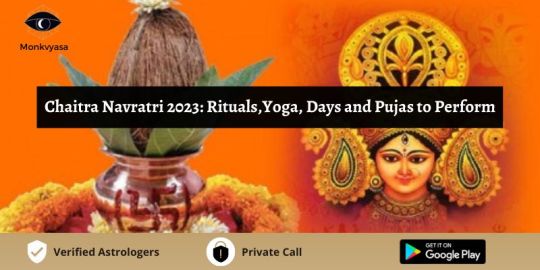
Navratri is a significant Hindu festival that is celebrated for nine nights on the Indian subcontinent during autumn. Traditionally, there are four seasonal Navratris, and the Sharada or Shardiya Navratri is celebrated after the monsoon season in remembrance of the Divine Feminine Devi. During this time, Hindus perform the customs and rites of Ghatasthapana and Sandhi Puja, which are considered to be the two most frequently observed muhurtas. Chaitra Navratri 2023 is particularly significant as it falls during the Shardiya Navratri, and Hindus observe the customs and rituals of Ghatasthapana and Sandhi Puja during this time.
The Navratri puja, also known as Vasanta Navratri, is a celebration that honors the sacred feminine Devi or Durga. Devotees worship and honor Divine Durga in her nine forms during this festival. The word "Vasanta" is derived from the Sanskrit language and signifies spring, which is when this Navratri occurs. It takes place during the Chaitra lunar month, which typically falls between March and April after the winter season. In some regions, this festival is celebrated after the spring season, while in others, it is observed after the harvest season. It is also significant as it marks the first day of the Hindu calendar, making it the Hindu New Year according to the Vikram Samvat calendar.
Chaitra Navratri 2023: Navratri days & pujas to perform
Here are the dates and details for Chaitra Navratri 2023:
Wednesday, 22 March 2023 (Pratipada): Maa Shailputri Puja and Ghatasthapana
Thursday, 23 March 2023 (Dvitiya): Maa Brahmacharini Puja
Friday, 24 March 2023 (Tritiya):Maa Chandraghanta Puja
Saturday, 25 March 2023 (Chaturthi): Maa Kushmanda Puja
Sunday, 26 March 2023 (Panchami): Maa Skandamata Puja
Monday, 27 March 2023 (Shashti): Maa Katyayani Puja
Tuesday, 28 March 2023 (Saptami): Maa Kalaratri Puja
Wednesday, 29 March 2023 (Ashtami): Maa Mahagauri Puja
Thursday, 30 March 2023 (Navami): Maa Siddhidatri Puja and Ram Navami
Friday, 31 March 2023 (Dashami): Navratri Parana
Chaitra Navratri is a festival where people worship the nine forms of Goddess Durga. They also try to find inner peace through meditation and seek happiness. During this festival, people also perform a ritual called Ghatasthapana or Kalash Sthapana. This involves setting up a sacred vessel for prayer. The Ghatasthapana Muhurta for Chaitra Navratri 2023 is from 06:23 AM to 07:32 AM.
Significance of Chaitra Navratri
Chaitra Navratri is an auspicious Hindu festival that commemorates the ultimate feminine form of the Hindu deity, Goddess Durga. She is regarded as Shakti, the most powerful feminine energy in the universe, and is worshiped with great devotion during this nine-day festival.
Navratri Puja is believed to bring immense wealth and fortune to those who seek the blessings of Goddess Durga. However, there are certain rules that the devotees must follow strictly, which include fasting without consuming grains, maintaining cleanliness, performing aarti and performing Ghatasthapana.
2 notes
·
View notes
Text
Pain Reliever Maa Durga Chalisa
Maa Durga is a Hindu goddess who is worshiped as the embodiment of divine feminine energy and power. She is known by many names, including Mahishasuramardini, which means the slayer of the demon Mahishasura.
According to Hindu mythology, Maa Durga was created by the gods to defeat the demon Mahishasura, who had become invincible due to a boon granted to him by Lord Brahma. Maa Durga is depicted as riding a lion, carrying weapons in her multiple arms and wearing a red saree. She is also known with various other forms like Kali, Bhagvati, Amba, Chandika and many more.
The festival of Durga Puja is celebrated every year in the month of October or November, depending on the lunar calendar. This festival is widely celebrated in India, especially in West Bengal, where it is considered the biggest festival of the year. During the festival, people decorate their homes with lights and flowers and set up pandals (temporary structures) where beautifully crafted idols of Maa Durga and her children are worshiped. The festival concludes with the immersion of the idols in a nearby river or lake, symbolizing the departure of Maa Durga and her children to their heavenly abode.
Maa Durga is believed to represent the triumph of good over evil, and her worship is said to bring prosperity, happiness, and good fortune. She is also considered the mother of the universe, and her devotees pray to her for guidance, protection, and blessings. The legend of Maa Durga and her victory over Mahishasura is a powerful reminder of the importance of courage, determination, and faith in overcoming obstacles and achieving success in life.
Maa Durga Chalisa
Maa Durga Chalisa is a devotional hymn dedicated to Goddess Durga, composed of forty verses (chaupai) in Hindi. The chalisa is recited by devotees to seek blessings and express their devotion to the goddess.
Each verse of the chalisa describes a different aspect of Maa Durga, her divine qualities and her accomplishments. The chalisa starts with an invocation to Maa Durga, asking for her blessings and protection. It then goes on to describe her form, beauty and strength. The verses also describe the various weapons and attributes of the goddess like her trident, sword and bow.
The chalisa narrates the story of Maa Durga's victory over the demon Mahishasura and how she destroyed various other demons who threatened the gods and the universe. The verses also describe the different forms of the goddess such as Kali, Bhavani and Ambika.
The chalisa concludes with a plea to Maa Durga to bless the devotee with her love and protection and to remove all obstacles and difficulties from their lives. The devotee also seeks forgiveness for any mistakes they may have made in their devotion to the goddess.
Reciting the Maa Durga Chalisa with devotion and faith is believed to bring blessings and good fortune to the devotee. It is often chanted during the auspicious occasion of Navratri, a nine day festival dedicated to the worship of Maa Durga and her various forms.
#maa durga chalisa#durga chalisa#shree maa durga chalisa#devi ki chalisa#maa durga ki chalisa#devi chalisa#chalisa of maa durga
2 notes
·
View notes
Text
Happy Dussehra to everyone from Paras Parivaar.
From the bottom of our hearts, we extend a warm welcome to you into the Paras Parivaar Charitable Trust family. In our Sanatan Dharm, this Parivaar was founded and is now being maintained by our Mahant Shri Paras Bhai Ji of Sanatan Dharm to contribute to the welfare of the underprivileged and needy people. Because he consistently states, “happiness of maa is behind their smile.” This idea of Mahant Shri Paras Bhai Ji has become the focus of our family’s daily activities.
The Paras Parivaar Charitable Trust works 365 days a year to lug our Paras Guru’s vision forward. We have helped more than 10 lakh Needy, and thanks to Maa and our Mahant Shri Paras Bhai Ji of Sanatan Dharm, this number is steadily rising. And it is the grandeur of Sanatan Dharm that we strive to assist those who cannot afford to pay for their education or who are food insecure.
Because we usually hear the quote “Unity is Strength” in everyday life, the Paras Parivaar Charitable Trust would like for you to join our family. We are certain that if we all work together as a single family, we will be stronger and more committed to helping more people in need. Serving an increasing number of individuals in need will enable us to carve out a large place in the heart of our Maa. So, join the Paras Parivaar now for the chance of a lifetime to make the poor and needy smile widely.
Working hard to boost the lives of the poor and needy would also help us reduce the rate of poverty and increase the rate of education in our nation. In addition to providing aid to those in need, our Mahant Shri Paras Bhai Ji wants to educate them so that they may become self-sufficient and contribute to the cause. join our Paras Parivaar Charitable Trust and aid those in need and destitute with what they need for food, shelter, and education.

After the holy and pleasant days of Shardiya Navratri, it is now time for the auspicious beginning of Hindu festivals. In Sanatan Dharma, all the major festivals begin after the celebration of Dussehra. Dussehra is celebrated on the Dashami Tithi of Shukla Paksha in the month of Ashwin. Dussehra symbolizes the happy victory of Lord Ram and Maa Durga over evil. The whole of India celebrates this grand and divine festival together. Two days from today, effigies of Ravana, Meghnad, and Kumbhakaran will be burnt in India’s main corners and streets. Paras Parivaar wishes you a very Happy Dussehra. Every year, this festival gives the message of victory of good over evil to the people.
Dussehra is celebrated all over the country, and the ways of celebrating it are different in every state. The enthusiasm for festivals remains throughout the Country as well as outside India at this time. In India, this festival is celebrated with full enthusiasm, zeal, and positive energy. This is the time when the whole country is immersed in full devotion and enthusiasm. The ways of celebrating this festival are also different in every part of the country. Some parts of the country celebrate this evening as the victory of Lord Shri Ram, and at some places as the Victory of Maa Durga.
Festival of Maa Durga:
It is also necessary to discuss two different dimensions of celebrating Dussehra. According to Shri Paras Bhai ji and study of mythology shows that when Mahishasur, due to the boon of the Tridev, created havoc in the world and the Devlok with his terror, Devas Didn’t find any solution and they reached the Tridev. After hearing this, Tridev created the great power in the form of Maa Durga from Their anger. Maa Navdurga, dedicated to Women’s Power, fought a fierce battle with Mahishasur for nine days, after which on the tenth day Maa Durga killed Mahishasur. This day is celebrated as Dussehra across the Country, where the Maa freed all the Devas from fear by destroying the demon powers. In West Bengal, these nine forms of Maa Durga are happily worshiped in huge Pandals, and Maa Durga is immersed on the day of Vijayadashami.
In the form of Shri Ram’s Victory.
In the Northern parts of India, Ramlila is organized in the nine days of worship of Maa Durga. This Ramlila is concluded with Ravana Dahan on the evening of Vijayadashami. According to the Ideology of Hindu Dharma scriptures, during the 14 years of exile of Shri Ram, Lankapati Ravana abducted Shri Ram’s wife Janaki Mata Sita. To bring back his wife safely and destroy Ravana’s unrighteousness and cruelty, Shri Ram killed Ravana after a tough penance and war.
After all this, the message of the victory of Dharma over Adharma is being expended throughout the World.
How do people celebrate Dussehra?
People this evening enjoy the Ramleela Manchan in their nearby areas. Where the artist, playing the role of Shri Ram, kills Ravana. Immediately after this, the effigies of Meghnad, Kumbhakaran, and Ravana are ignited one after the other. Everyone experiences the glow and divine light of these dazzling fireworks with their own eyes. They consume prasad and sweets. Everyone approves of the joy of unity by enjoying the fairs organized in the cities. Fairs and fireworks are organized all over the country on this day. People enjoy this grand and lively night with their family and friends. They wear new clothes and enjoy the joyous atmosphere outside. In Gujarat, like the holy nine days, Dandiya and Garba are also organized on Vijayadashami. In big cities like Delhi, the splendor of Ramlila Maidan is also worth seeing, where big politicians burn Ravana. This increases the enthusiasm of this festival even more among the general people. This day is very special for all Sanatanis in Sanatan Dharma, their deity Shri Ram kills Ravana. This makes the voice of joy among the devotees even stronger.
#paras#parasparivaar#parasbhaiji#jaimatadi#hindudharam#dussehra#ramnavmi#religion#hinduism#sanatandharm
0 notes
Text

As we celebrate the triumph of good over evil on Durga Navmi, let us remember the unwavering strength and compassion of Maa Durga. May her nine forms inspire us to overcome challenges, embrace our inner power, and protect those around us. Let us invoke her blessings for peace, prosperity, and harmony in our lives and in the world. Happy Durga Navmi!
#DurgaNavmi#Navratri#JaiMataDi#GoddessDurga#DivineFeminine#StrengthAndCompassion#OvercomeChallenges#EmbraceYourInnerPower#PeaceAndProsperity#GSuniversity#Delhincr
0 notes
Text
Day 8 of Navratri, also known as Durga Ashtami, is dedicated to Maa Mahagauri, the eighth form of Goddess Durga. The colour associated with Ashtami is Pink. This vibrant shade represents hope, beauty, and universal love, reflecting the gentle and compassionate nature of Maa Mahagauri.
In 2024, Day 8 of Navratri spans October 10 and 11, with Durga Ashtami marking one of the most important days of the nine-day festival. The day also sets the tone for the final celebrations of Navratri, preparing devotees for the culmination of the festival on Navami and Vijaya Dashami.
0 notes